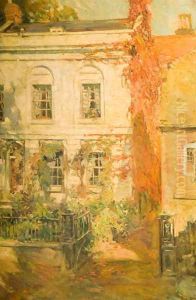William Christian Symonds Paintings
William Christian Symonds was a British artist born in 1845. Not as widely known as some of his contemporaries, Symonds' work primarily encompassed landscape painting and illustrations. He was born into a period where the art world in Britain was undergoing significant changes, with movements such as the Pre-Raphaelite Brotherhood challenging conventional approaches to art.
Symonds' artistic journey was reflective of the Victorian era's fascination with nature and the romanticization of the countryside. His landscapes often depicted the tranquil and pastoral scenes of Britain, resonating with a public that was increasingly urbanized and nostalgic for the rural. Aside from landscapes, Symonds also engaged in creating illustrations for books, a popular medium during his time due to the rise of publishing and literacy rates.
Throughout his career, William Christian Symonds remained a modest figure in the art world, with limited information available about his personal life and artistic endeavors. He did not achieve the same level of fame as some of his peers, and as a result, his work did not have a significant influence on subsequent generations of artists. Despite this, his contributions to landscape painting during the Victorian period are still appreciated by art historians and collectors.
Symonds passed away in 1911, leaving behind a body of work that, while not transformative, captures the essence of the British landscape during a time of great change and industrialization. His paintings today can be seen as a window into the past, reflecting the sensibilities of a society in transition and an artist's love for the natural world.
